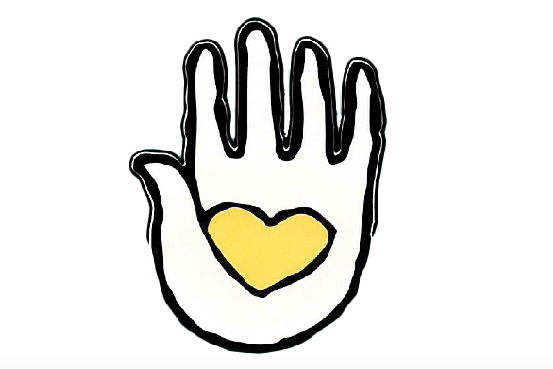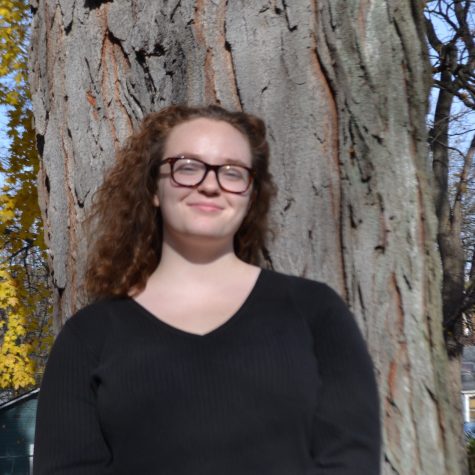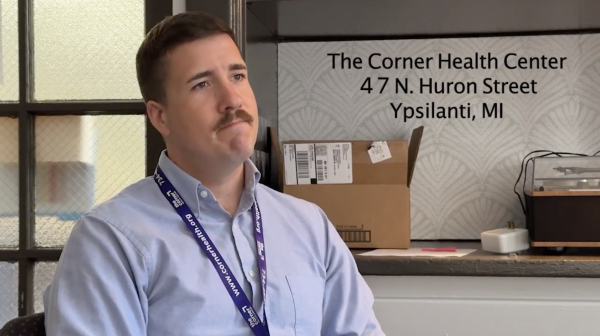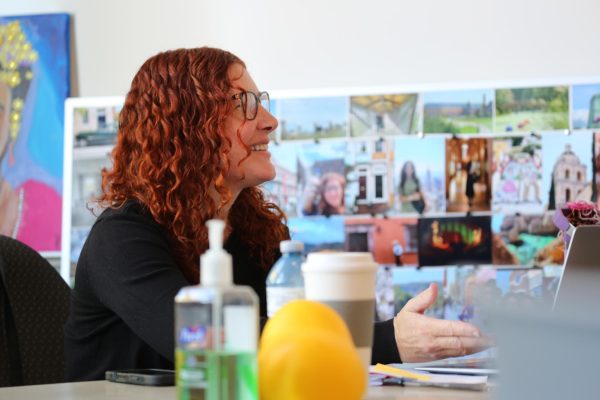Nothing but Yes Means Yes
Disassembling stigma and stereotypes one sexual health program at a time.

Anne Huhman sits stoic in her agreeable office, accommodating and collected. In the cluttered quiet of the University of Michigan Union, her office lies in the deepest ventricle of the building. The fluorescent lights gently hum, while students cross the grassy Diag outside. This day, as all others, has been drastically different from the last.
Huhman, Program Manager for Education and Prevention at the University of Michigan Sexual Assault Prevention and Awareness Center, or SAPAC, finds that everyday presents new challenges, new adversaries and new opportunities to educate her clients and her campus about sexual assault.
In a new day and age, the world seems ready to tackle the topic of rape.
Those who come into the office are greeted by pamphlets, pins, temporary tattoos and a serene environment, homey and inviting. The words “YES MEANS YES” cover the walls and posters. Huhman constantly stressed how important it was to her that the survivors that come into her office are as comfortable as possible.
“We use the term survivor, just because it feels a little bit more empowering for somebody who’s actually gone through something really traumatic and survived it,” Huhman said. Typically, the employees at SAPAC will handle the aftermath of an attack, and provide the survivor with the tools that they need to cope.
Although SAPAC only caters to the needs of those who attend the University of Michigan, they will still direct other survivors to places like Safe House, which rests on the outer edge of Ann Arbor. Survivors have access to a 24-hour crisis line operated by professionally trained staff members, time to meet with employees and assistance in processing prior events.
The University of Michigan has three student programs advocating against sexual harassment on their campus, consisting of 150 student volunteers. The Peer Education Program focuses on primary prevention of sexual violence. This stage of prevention centers its practice around adopting healthy behaviors with relationships, consent and communication. The program presents this information to U of M students in hopes of reaching out to various programs at the U of M such as fraternities and sororities.
Secondary prevention is covered by the Bystander Intervention and Community Engagement program. They teach students how to intervene safely in harmful situations in order to support one another. The program provides various workshops teaching these skills. They collaborate with other student groups that haven’t normally worked with places like SAPAC, such as the Greek system and athletics.
The Networking Publicity and Activism program deals with tertiary prevention. Their main focus is to raise awareness by providing information about SAPAC itself at all the school fairs, and by planning and organizing some of the larger events. Every November, they hold a survivor speak out event that provides a safe and supportive environment for survivors to share their stories. Following that, the program holds an art show every spring, centered around raising awareness through art.
SAPAC was developed in the mid-eighties by student activists who wanted on-campus resources for sexual assault. At the time, the University of Michigan offered no center or phone-line for those affected by rape. A group of students staged a sit-in at the Student Life Vice Principal’s office and demanded that a rape crisis center be opened. After its creation, SAPAC was run mostly by students and activists until it became a professional setting, although many students volunteer to this day. A vast majority of college campuses are just beginning to provide resources for their students, whereas SAPAC has been providing its services for roughly 30 years.
There are many factors that can contribute to how someone is affected by personal trauma, like social identity, family support and culture. SAPAC understands that they don’t always know best, so they help survivors based on the complex basis of each person’s life, and the most important thing is to unconditionally support them as they take the next step in the healing process.
Although SAPAC has made an outstanding difference in the Ann Arbor community, sexual assault is still the most underreported crime, especially in Michigan. Before every student’s enrollment at U of M, they are required to take a campus climate survey. The survey, which asks questions ranging from intervention methods to how to report, indicates that 46 percent of the people who have experienced sexual assault reported it. Out of that group, only three percent reported to an official university resource, including law enforcement.
Sexual assault is the number one least-reported crime in the United States. But why would there be many circumstances of rape yet so few incarcerations? Why would people be afraid to go to the police to report a crime they knew had been committed against them?
“[There is] fear of not being believed and that’s a big barrier,” Huhman said. “Fear of the perpetrator and what they would do to them if they find out they reported it. If the survivor and perpetrator are part of the same social circle, that can be really challenging because they are trying to weigh if they should report it and risk fracturing the social circle.”
In some cases, the initial reaction of some reported cases could be “what did this person do to bring this on themselves?” It is as if the rape is blamed on the survivor and not the rapist. This sort of blame is called victim-shaming and is a major part of rape culture today.
“[Victim-shaming] is counterproductive and really negative,” said Siena Mckim, a U of M student. “To shift the blame… It’s wrong. And I think that it diminishes image, as if women are second class citizens.”
A gross overgeneralization is that rape only happens to women. Sexual assault can happen to anyone, regardless of gender, race or sexual identity. SAPAC sees more women than men, due to toxic masculinity. Toxic masculinity is the perpetuation that men are stronger and cannot show emotion like women can. Ideas like this slow the progression of our ability to combat gender norms and make statistics foggier, like that in the Climate Change Survey. SAPAC hired a male advocate to help break down barriers that men might see.
“There are these stereotypes that it only happens to women, but we know it happens to all gender identities,” Huhman said. “It’s hard for men to come forward and report. So we end up seeing more women, but we also see men. We are trying really hard to make sure that people know that this is a place that is inclusive for all gender identities. We are here to support all.”
Following the trial of a rapist by the name of Brock Turner, the topic of sexual assault became far more socially prevalent. After committing sexual assault at his college, the University of Stanford, Turner was sentenced to six months in jail, a lenient and unjust ruling, which was eventually brought down to three months for “good behavior.” A major issue was the fact that the media that covered the story seemed to cover his accomplishments, highlighting him as a talented swimmer and intelligent student, and not the fact that he had committed a federal crime. To those who have experienced sexual assault, this is a slap in the face and a failure on part of both the legal system and modern day media.
Matt Harmon, a freshman at U of M, was disgusted by the poor judgement and the case in its entirety. Harmon also suggested that the weak ruling may have been affected by the fact that Turner was a swimmer for Stanford.
“The university is there to make sure everyone should feel safe, not just the people who make them look good,” Harmon said.
Mitchell Lawrence, an 18-year-old high school student was sentenced to two years in jail for possession of a teaspoon of marijuana. Marissa Alexander, a Floridian woman, was sentenced to 20 years in prison for firing a warning shot out of a gun to scare her abusive husband away from her. Yet rapists like Brock Turner, David Becker, Nicholas Fifield, and John P. Enochs walk away from trials, with probation, fines or lenient sentences. Often times, the rapist is portrayed as the victim, in the sense that their occupations and talents are mourned if they go to jail. Infamous rapists are known, not for committing crimes, but for the careers that ended when they were found guilty.
“It’s really important that we really hold perpetrators accountable,” Huhman said. “What kind of message does [three months] send? To me, that is a failure on part of the legal system. Yet, there is so much activism and awareness surrounding this case. I’m glad to see the public outcry. When people demand change, is when we will see it.”
SAPAC works diligently on campus, with fraternities, sororities and the school itself. The interfraternity Council (IFC), consisting of ten elected executive council members and a body of fraternity representatives, requested SAPAC to be a part of their yearly orientation program for two consecutive years.
For all incoming students going into a fraternity, SAPAC provides the necessary information on sexual violence prevention, consent and bystander intervention. According to Huhman, some fraternities on campus have become broad allies to SAPAC, and are actively working to be part of the solution.
To those entering a college campus, the future is bright, and taking the time to ensure you have good relationships with communication is key. Empower your individuality and autonomy. And teach the world, not to not drink or to not wear revealing outfits, but to not rape.
“Be proactive in who you are, and who you want to surround yourself by,” Huhman said. “You have the right to do what’s best for you and to communicate that to someone else. Know who you are. Practice communicating that. It takes time. It’s one thing to know what you want. It’s another thing to be able to communicate that to others.”








